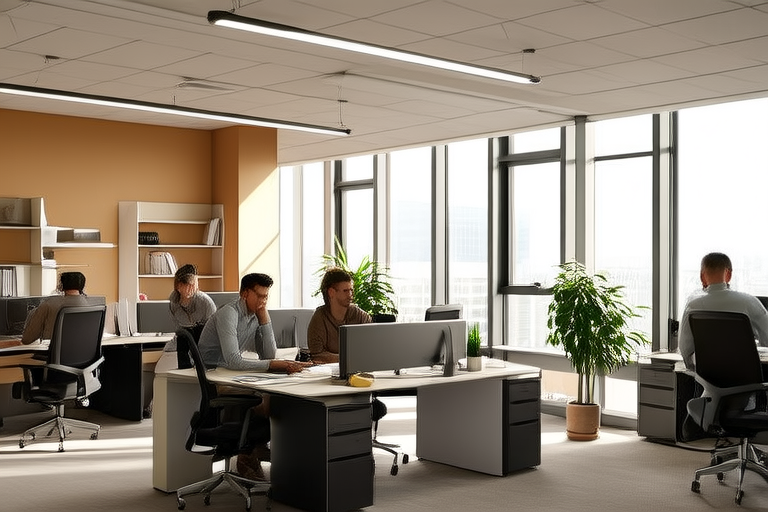10 Tips for Enhancing Health & Comfort in the Modern Workplace Environment
Introduction
In today’s fast-paced world, the modern workplace environment plays a crucial role in both productivity and employee well-being. A comfortable and healthy workspace can significantly improve focus, reduce stress, and increase job satisfaction. This article will explore ten practical tips to enhance health and comfort in your office, ensuring that you and your colleagues thrive in a supportive and efficient environment.
1. Ergonomics: The Foundation of a Healthy Workspace
Ergonomics is the study of designing workspaces to fit the people who use them. Proper ergonomic setup can prevent repetitive strain injuries and promote better posture. Here’s how you can optimize your workstation:
Adjust Your Chair
Your chair should support your lower back and allow your feet to rest flat on the floor. Ensure that your knees are at a 90-degree angle or slightly below it. Adjust the armrests so they don’t interfere with your typing or mouse movement.
Position Your Monitor
Place your monitor directly in front of you, about an arm’s length away. The top of the screen should be at eye level. This helps avoid neck strain and promotes better posture.
Use an Adjustable Keyboard and Mouse
Consider using an adjustable keyboard tray to keep your wrists straight while typing. Opt for a vertical mouse if you experience wrist discomfort from prolonged use of a traditional mouse.
2. Lighting: Brighten Up Your Space
Lighting is one of the most overlooked aspects of workplace design. Poor lighting can lead to eye strain, headaches, and reduced productivity. Here’s how to get it right:
Natural Light
Maximize natural light by positioning desks near windows. If this isn’t possible, consider using full-spectrum LED bulbs that mimic natural daylight. These lights help maintain circadian rhythms and boost mood.
Task Lighting
For areas where detailed work is done, such as reading or writing, add task lighting. Desk lamps with adjustable arms can provide focused illumination without causing glare.
Avoid Glare
Ensure that computer screens are not directly facing windows or bright lights. Use blinds or curtains to control the amount of sunlight entering the room.
3. Temperature Control: Finding the Perfect Balance
Maintaining a comfortable temperature in your workspace can greatly affect concentration and comfort levels. Here’s what you need to know:
Personalized Heating and Cooling
Invest in individual heating and cooling units like space heaters or fans. These allow each person to adjust their environment according to personal preference.
Dress Appropriately
Encourage employees to dress in layers. This way, they can easily adapt to changes in room temperature throughout the day.
Ventilation
Ensure good airflow by opening windows or using air purifiers. Fresh air improves cognitive function and reduces the spread of germs.
4. Noise Management: Creating a Quiet Haven
Noise pollution can be a significant distraction in open-plan offices. Here’s how to manage it effectively:
Soundproofing Materials
Use sound-absorbing materials like acoustic panels or soft furnishings to reduce echo and background noise.
Headphones
Offer noise-canceling headphones to employees who need a quiet environment for focused work.
Designated Quiet Zones
Create specific areas within the office designated for quiet tasks. Clearly mark these zones and enforce respectful behavior.
5. Greenery and Aesthetics: Bringing Nature Indoors
Adding plants and appealing decor can make your office more inviting and pleasant. Here’s how to incorporate nature into your workspace:
Indoor Plants
Plants not only beautify spaces but also improve air quality. Choose low-maintenance varieties like spider plants or pothos that thrive indoors.
Artwork and Decor
Select artwork and decor that reflect the company’s culture and values. Personalize each desk with small items like photos or trinkets that inspire creativity.
Feng Shui Principles
Consider applying basic feng shui principles to create balance and harmony in your office layout. For example, place water features near entryways to symbolize wealth and prosperity.
Practical Case Study: Implementing Ergonomic Changes
Let’s take a look at a real-world example of how one company successfully implemented ergonomic changes:
Company XYZ
Company XYZ noticed an increase in employee complaints about neck and shoulder pain. They decided to conduct an ergonomic assessment of their workspace. After identifying problem areas, they invested in new chairs, adjustable monitors, and keyboard trays. Within six months, they reported a 30% reduction in sick days and a 20% improvement in overall job satisfaction.
Summary and Actionable Steps
In summary, enhancing health and comfort in the modern workplace requires attention to detail across multiple dimensions. By focusing on ergonomics, lighting, temperature control, noise management, and aesthetics, you can create an environment that supports productivity and well-being.
Actionable Steps:
- Evaluate Current Setup: Conduct a thorough review of your current workspace.
- Prioritize Key Areas: Identify which areas (e.g., ergonomics, lighting) need immediate attention based on feedback from employees.
- Implement Changes Gradually: Start with small adjustments and gradually introduce larger changes over time.
- Monitor Progress: Regularly check in with employees to assess the effectiveness of implemented changes.
By following these steps, you can ensure that your workplace remains a comfortable and productive environment for everyone involved.
